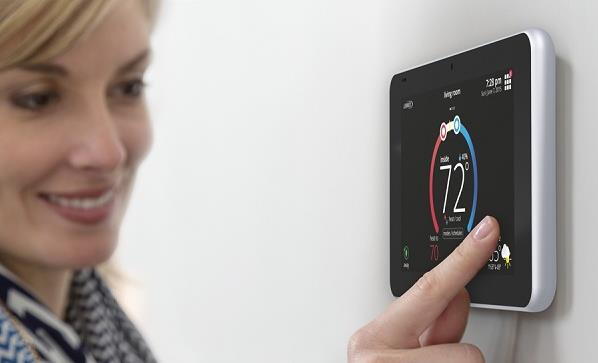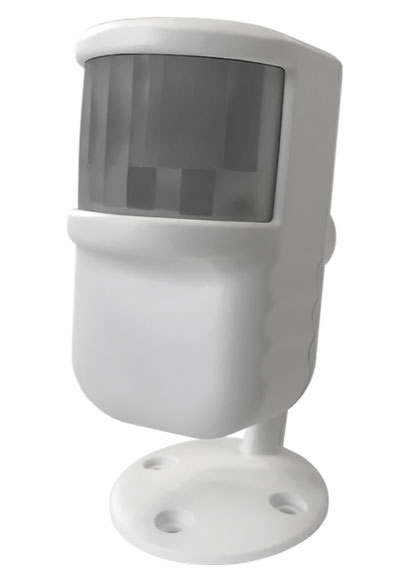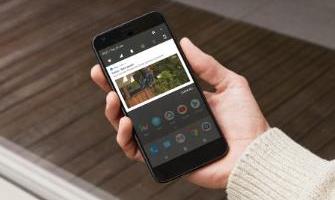
REMOTE MONITORING:The iComfort S30 by Lennox has a consumer and dealer dashboard that facilitates remote monitoring and diagnostics, saving the cost of an initial service trip or a trip for parts the technician didn’t know were needed.
It’s no secret that in the HVAC field,IoT is where it’s happening.
It started with smart thermostats. Now, in today’s world of smartphones, smart speakers, and Wi-Fi connections in 89 percent of U.S. households (as of 2017), smart homes are expanding in scope beyond heating and cooling controls — the first major foray into the smart-home concept — as manufacturers work to keep up with customer demand for continuous connection.
“If you look at it from an HVAC perspective, the biggest trend I see is the expansion outside HVAC,” said Gene LaNois, head of pro channel at Nest Labs. “Traditionally, this was really thermostat centric. When I started this role [at Nest] five years ago, the vision was to enable HVAC to be more than just a thermostat — get them to adopt into the entire IoT: the smart home. Now all of a sudden, because of everything operating in one app and under the same brand, we’re seeing HVAC contractors sell cameras, sell doorbells.”
MORE THAN JUST A THERMOSTAT
With a traditional trade like HVAC, stepping into smart product categories is the biggest change LaNois has seen in his 20-plus years in the industry.
“We’re seeing one: expansion of product and two: deeper integrations … really relating back into the heart of HVAC, which is heating and cooling systems,” he said. “People are literally expecting to be able to have things work together. It’s going from being something unique to something that’s a lot more everyday.”
With a multitude of IoT-enabled devices on the market, more manufacturers will seamlessly integrate their products across various platforms.
“We’re looking at it, with IoT, as a whole system integration,” said Blake Edwards, senior product marketing manager, controls, Lennox. “Everyone nowadays wants multiple devices to tie in [to one app], whether it’s blinds, the HVAC system, garage doors. We want to be able to partner and tie into that — especially with more people taking that holistic approach to their lifestyles and realizing the importance of indoor air quality.”
Smart thermostats, ceiling fans, and air purification systems are one thing, he continued; smart locks, lights, garage doors, and surveillance cameras are another thing altogether. And while they’re still part of the smart-home ecosystem, Edwards said HVAC manufacturers should focus on being a partner, not a provider, of those components.
“Our focus is on what we do best,” he said. “We’re not a lighting company; we don’t do locks. So the question becomes, how can we position our platforms to support other devices”

MARKET DRIVER:David Moss, CTO, People Power, predicted that senior care will drive the market for residential IoT devices, like the company’s temperature and motion sensors (pictured above)
That means really looking at the home as an ecosystem, said David Moss, CTO of IoT software company People Power.
“We’re continuing to see ‘hero’ products come out: Nest, ecobee, Ring doorbells, even things like Amazon Echo and Google Home,” he said. “It’s a physical product, and it contains a cloud, and it contains an app, and it’s ready to go for consumers. It’s something to talk about: a centerpiece. And what we need to do is get beyond individual devices and make it all work well together across multiple ecosystems — coordinating all of the devices in the home with a higher level of intelligence so that it really feels like someone is there taking care of you. In other words, you as a user should not have to think about your smart home; your smart home should be thinking about you.”
Companies that can work together across platforms stand the best chance of succeeding in what is still a fragmented market, he said.
“It is too early in the Internet of Things market to be placing bets on any one ecosystem or hardware provider,” he said. “What’s really important is to have a platform that enables multiple manufacturers over multiple protocols to work together … so you do not have to worry about whether this product from this company will work with that product from that company.”
WHAT’S DRIVING DEMAND
The old “there’s an app for that” joke might be stale, but the rationale behind it remains as strong as ever.
“I think the artificial intelligence that we’ve built into the thermostat is a huge, growing trend,” said LaNois. “When I first said it, it was more of a marketing term than a real, viable feature set. Now a few years later, we’ve had contractors watching it work in homes … and that has created a huge push for, how do you get more intelligence like that in the other products So we’ve got manufacturers creating dynamic products that can do a multitude of things — learn the spaces they’re in — once they’re installed.”
Voice-activated technology is definitely one of those trends, and although it still needs a lot of work, it’s setting a benchmark, Moss predicted.
“When I was a kid, my first computer was a Commodore 64,” he said. “Every time I say the keyword ‘OK Alexa or ‘OK Google,’ my 1-year-old son … he gets it. That’s his Commodore 64. It’s something that we’re just starting to scratch the surface of and will continue to get more sophisticated.”
It all comes down to the ubiquity of connectivity and prevalence of smartphones, said Greg Polce, vice president of product planning, White-Rodgers for Emerson Commercial and Residential Solutions. “When you get into smartphone products, ultimately it’s to make life easier, and ultimately in HVAC, to make our lives more comfortable,” he said — although he added a caveat: many so-called smart products don’t offer a clear benefit.
“Clearly, we are seeing increased penetration, starting with speakers and voice,” Polce continued. “With our Sensi thermostats, we aim to offer the best service possible, from the contractor installing it to the homeowner using it every day. But, just because you can add Wi-Fi doesn’t mean you should.”
Across the industry, current demand for IoT-enabled home automation devices skews toward homeowners in the 35-and-up range, according to Mallory Richards, communications manager at Google.
“These are people who have grown up with tech in their lives; they’re at a point where they’re starting their families, and they want this tech touch,” she said. “They’re more established in their home, versus more of the millennial coming out of college, buying their first home, where it’s a bit more difficult to adopt big-ticket items.”
Part of the price resistance — an ongoing issue in the industry from the start — is counteracted by the general buzz about smart products, as more people adopt IoT-enabled technology and share the results with their friends, LaNois said.

INDIVIDUAL CONTROL:Consumers expect the ability to control all their smart-home devices — thermostat, blinds, lights, surveillance camera (like the Nest Cam, pictured) — from a single smartphone platform.
“They go on Twitter and talk about the ability to save money, or post the footage from their Nest Cam that caught an awesome family moment or saved their property.”
Moss predicted a different driver emerging in the market: care.
“My perspective is, while communication and convenience have been some of the more prominent use cases early in this market, it will really be services around safety, security, and caring for others that are more of the killer applications: making sure your home is protected from an infrastructure perspective, making sure no one is breaking in while you’re gone, and caring for others — for pets, children, senior loved ones,” he said. “Those are much more complex scenarios to offer.”
Senior care is one of the largest market opportunities in this space, Moss continued, and in his view, nobody has done it right yet.
“From a demographics perspective, the senior care market will continue to grow until about 2050,” he said. “There are far more seniors to be taken care of than there are caregivers who can provide that care, so if we can augment humans with smart-home intelligence, that enables caregivers to take care of more seniors. Every single one of us will run into this at one point: taking care of an aging relative. That is probably the most important thing that People Power’s working on.”
At the end of the day, it’s not really about the gadgets, said Moss.
“My grandma lives alone, and if anything goes wrong at all, I want a network of people around her,” he said. “It’s about connecting people. It’s about making smart homes social. It really takes a company tackling the entire IoT space, meaning you’re doing energy, doing safety, doing security, and on top of that, you’re adding other elements. Every single gadget is ultimately a component of well-rounded senior care.”
BENEFITS FOR CONTRACTORS
Some of the reasons that get homeowners excited for smart-home technology — connectivity, convenience, and cost savings, for example — apply to contractors looking to get into the business as well.
“The biggest benefit, depending on the contractor’s offering, is that they’re meeting the trending needs of the market of today’s tech-savvy consumers,” said Edwards. “If they don’t, they’re really doing themselves a disservice. By not catching up, they’re going to be left behind.”
Having that offering helps dealers and contractors stand out in the market. It also helps keep them connected to their customers, which translates into increased potential for sales opportunities.
“There are lots of different types of people who have their hand in your home, and the companies that actually want to maintain or grow relationships with their customers stand to benefit the most with IoT products,” Moss said. “We have a couple different services that run in the home today, and can enable contracting companies to know proactively when something is going wrong inside one of their customers’ homes, and alert them so they can call the customer and say ‘we need to get back in your house and check on your HVAC system.’”
Not only does this help the contractor gain recurring business, but it also helps build trust from the customer. So when it comes to replacing high-cost appliances, that personal relationship — facilitated via IoT products — will put the contractor in the best place to make that sale.
Some companies, like People Power, also spiff installers who sell their products.
“Say we want to upsell [the customer] on an internet-connected device … An installer convinces them to let them install the product, and on our platform, that installer can earn points,” said Moss. “It’s a nice way to incentivize them on a behavioral level.”
There’s a practical side, too. With remote monitoring, contractors need less manpower because there’s less wasted time. For example, the iComfort S30, Lennox’s ultra-smart thermostat, has a consumer and dealer dashboard that facilitates remote monitoring and diagnostics, saving the cost of an initial service trip or a trip for parts the technician didn’t know were needed.
Emerson’s smart HVAC maintenance solution, soon to be launched, uses remote sensors to monitor a resident’s HVAC system.
“With homeowners who have an HVAC service agreement, usually you come out twice a year,” Polce said. “With this system, you can check every month, not once every six months, and you can schedule it remotely. On the contractor’s side, it helps them gain more customers, as well as lowering the cost to serve them. They can do more work with the same amount of technicians because they can go out only if there’s a problem.”
As contractors increasingly offer smart-home automation as one of their regular services, awareness will spread, and more people will join in.
“We’ve got a partner in the industry, American Residential Services, and they’re the largest heating and cooling and plumbing contractor in the United States,” said LaNois. “Last year, if you went to their website, it said heating, cooling, and plumbing. This year, it says heating, cooling, plumbing, and smart home. It’s a great example. Seeing that one of their leaders in the industry is in the space in a meaningful way … it validates the business.”
Edwards believes IoT-enabled residential products are already becoming mainstream.
“More and more, you’re talking to people who have a smart thermostat in their home, a smart doorbell, smart TV,” he said. “You’re not gonna have a lot of challenges with people adopting them, because in the past it wasn’t the norm, but now it is.”
For LaNois, the “cool” factor of IoT-enabled HVAC products could be the key to overcoming the labor shortage in the trades.
“It’s [about] recruiting great talent, getting younger generations to be interested in the trade space … Selfishly, I think tech’s the solution,” he said. “Our stuff is cool! It attracts a newer audience. Sheet metal and air conditioners aren’t necessarily cool anymore — they’re great, but they aren’t necessarily getting the attention of kids in school.
“We bring really cool and customer-desired technology,” LaNois continued. “It’s an opportunity to recruit into the business. It doesn’t necessarily need to be that you’re a service technician with a set of gauges or a sheet metal person. You can be a tech person and then learn the other aspects of the business afterward.”